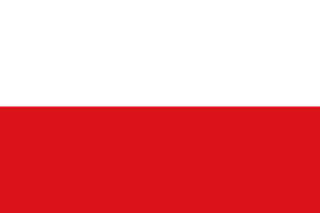
Tyrol is an Austrian federal state. It comprises the Austrian part of the historical Princely County of Tyrol. It is a constituent part of the present-day Euroregion Tyrol–South Tyrol–Trentino. The capital of Tyrol is Innsbruck.
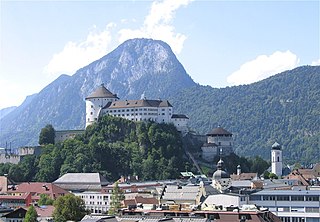
Kufstein is a town in the Austrian state of Tyrol, the administrative seat of Kufstein District. With a population of about 20,000 it is the second largest Tyrolean town after the state capital Innsbruck. The greatest landmark is Kufstein Fortress, first mentioned in the 13th century. The town was the place of origin of the Austrian noble family Kuefstein.
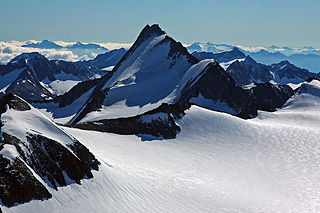
The Ötztal Alps are a mountain range in the Central Eastern Alps, in the State of Tyrol in western Austria and the Province of South Tyrol in northern Italy.

Landeck is a city in the Austrian state of Tyrol, the capital of the district of Landeck.
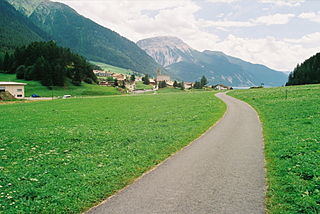
Reschen Pass is a mountain pass across the main chain of the Alps, connecting the Upper Inn Valley in the northwest with the Vinschgau region in the southeast. Since 1919, the border between South Tyrol, Italy and Tyrol, Austria has approximately followed the watershed, the pass summit at a height of 1,504 metres (4,934 ft) being completely on Italian territory.

Lofer is a market town in the district of Zell am See in the Austrian state of Salzburg.

Graun im Vinschgau is a comune (municipality) and a village in South Tyrol in northern Italy, located about 70 kilometres (43 mi) northwest of Bolzano, on the border with Austria and Switzerland.
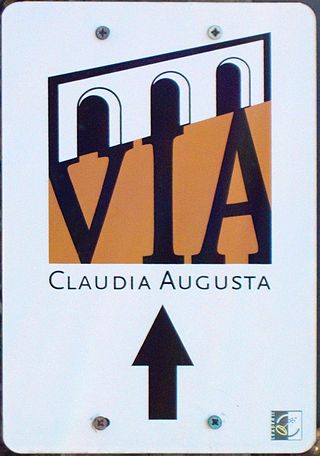
The Via Claudia Augusta is an ancient Roman road, which linked the valley of the Po River with Rhaetia across the Alps.

Zams is a municipality in the district of Landeck in the Austrian state of Tyrol.

Lesachtal is a municipality in Hermagor District, in the Austrian state of Carinthia. It comprises the western part of the eponymous valley formed by the upper Gail River, and stretches from the Carinthian border with East Tyrol down to Kötschach-Mauthen in the east.

Sillian is a market town in the district of Lienz, in the Austrian state of Tyrol.

The Kaunertal is a municipality and alpine valley in the Landeck district in the Austrian state of Tyrol. The municipality is located about 15 km (9.3 mi) southeast of Landeck at the upper course of the Inn river.

Prutz is a municipality in the Landeck district in the Austrian state of Tyrol. Located at the mouth of the Kauner valley on the upper Inn, it is 10 km south of the city of Landeck and 36 km north of Reschen Pass, that forms the border to Italy. The border to Switzerland is located 23 km away towards the south-west.

Spiss is a municipality in the district of Landeck in the Austrian state of Tyrol located 22 km south of the city of Landeck at the border of Switzerland. It is one of the smallest communities in the district. Formerly a part of Nauders, it became its own municipality in 1547. The main sources of income nowadays are tourism and agriculture.

Biberwier is a municipality with 612 inhabitants in the district of Reutte in the Austrian state of Tyrol. The municipality is located in the district court Reutte.

The Deutsches Eck is the name given to the shortest and most convenient road and railway link between the Austrian metropolitan region of Salzburg and the Tyrolean Unterland with the state capital Innsbruck.

Tyrol is a historical region in the Alps of Northern Italy and western Austria. The area was historically the core of the County of Tyrol, part of the Holy Roman Empire, Austrian Empire and Austria-Hungary, from its formation in the 12th century until 1919. In 1919, following World War I and the dissolution of Austria-Hungary, it was divided into two modern administrative parts through the Treaty of Saint-Germain-en-Laye:
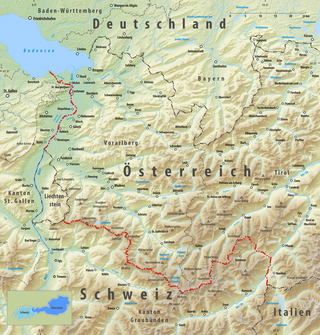
The border between the modern states of Austria and Switzerland is divided into two parts, separated by the Principality of Liechtenstein, with a total length of 180 km (110 mi). The longer, southern stretch runs across the Grison Alps and the shorter one following mostly the Alpine Rhine, except near Diepoldsau and between Lustenau and Lake Constance, where it follows the Old Rhine bed. The border continues northward to the Austrian-Swiss-German tripoint located within Upper Lake Constance.
Oberes Gericht is an area in the southwest of Austria and one of 36 microregions of the federal state of Tirol. The area located in the Landeck District reaches from Pontlatzbrücke to Finstermünzpass. It borders Switzerland in the southwest and Italy in the south. According to data from January 2016, the area counts 12,787 inhabitants. Most of the settlements in the area are located among the river Inn and form part of the Inntal. In addition the area compromises another side valley of the Inntal called Kaunertal.

The Austro-Hungarian fortifications on the Italian border were constructed in the 19th and early 20th centuries to protect against invasion from Italy. Most were built in what is today the Trentino-Alto Adige region; some built outside this territory were ceded to Italy after 1866. By the First World War many of them were obsolete, but nevertheless played a role in deterring and containing Italian assaults.























